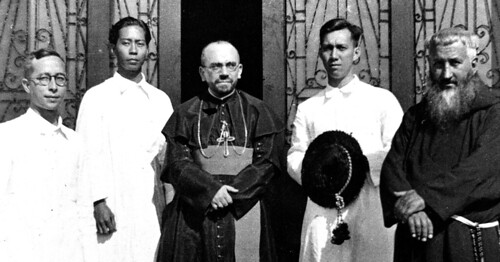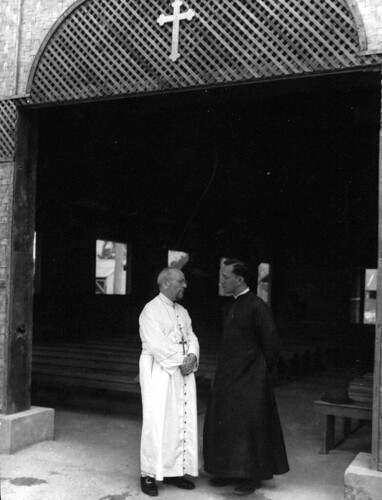Bishop Miguel Angel Urteaga Olano
Last Spanish bishop of Guam
For almost 300 years, the Spanish overseas Catholic missions took firm root in the Marianas. Spanish clergy and superiors — Jesuit, Augustinian Recollect or Capuchin — governed the Catholic Church in the Marianas. However, on 26 October 1945, that era came to a close with the departure of Miguel Angel Olano Urteaga, OFM Cap., the last Spanish bishop of Guam.
Personal background
Olano was born on 29 September 1891, in the small Spanish hamlet of Alzo in the Basque Province of Guipuzcoa. His father was Miguel and his mother, Josefa, had passed away when Miguel was just a small child. In 1903 Olano entered the Capuchin minor seminary, called the Seraphic School, in Estella, Navarra, Spain. In 1907 he formally entered the Capuchin Order, taking on a religious name, Leon de Alzo. Two younger half-brothers, sons of his father by a subsequent marriage, Miguel and Diego Jose, also became Capuchin Friars.
Olano was ordained a Capuchin priest on 18 December 1915, after completing philosophical and theological training. For the first three years of his priesthood, he preached in the Spanish and Basque languages. The Capuchin province to which Olano belonged, the Navarra Province in northern Spain, included the Basque cultural and linguistic region. For about two years, from 1916 until 1918, he was stationed at the Capuchin Friary in Fuenterrabia, Guipuzcoa.
Assignment to Guam
In 1918 Olano was assigned to the Catholic Mission of Guam which in 1914 had been transferred by Rome to the jurisdiction of the Navarra Capuchin Province. Distance and limited transportation would bring Olano to Guam a year later on 1 March 1919. Three other new Capuchin missionaries, Fathers Jose Luis de Azcoitia, Anselmo de Zuniga and Bernabe de Caseda, accompanied Olano. Like all incoming missionaries, Olano spent his first months on Guam learning the language and the customs of the island under Fr. Roman Maria de Vera. Olano was then sent to Sumai as parish priest of Our Lady of Guadalupe parish.
By the time Olano took up residence in Sumai, the town was the second most populated municipality on Guam. It was the site of the United States naval station, the port of entry for all imported goods and ship passengers, and when air transportation became possible in the late 1930s, the location of the Pan Am Clipper station and hotel.
Pale Leon, as Sumai parishioners called him, quietly encouraged the spiritual devotion of his flock. His peaceful manner won him a place in the hearts of the people of Sumai and his pleasant demeanor allowed him to relate cordially with the American population.
Olano performed daily pastoral work typical of Capuchin missionaries on Guam at the time. He celebrated daily Mass, taught daily catechism to children, preached in CHamoru and English, and visited the sick. He renovated the church at the cost of $9,000 and established a young women’s group in Sumai called Hijas de Maria. When vacancies arose in the neighboring parish of Hågat, Olano took charge of both village parishes. For a time, he traveled to Berkeley, California, to improve his English at St. Mary’s High School, run by the Christian Brothers. He also served as councilor to the Capuchin superior on Guam, and in 1933 was named Capuchin superior.
Pope names Olano bishop
On 9 July 1934, the pope appointed Olano to the higher office of bishop. Olano replaced the elderly Bishop Joaquin Felipe Olaiz Zabalza, OFM Cap., who retired to his hometown of Pamplona, Spain.
On his way to Spain for his episcopal consecration, Olano passed through the Holy Land, visiting many landmarks. He also met Pope Pius XI in November 1934, before reaching his destination in Spain. He was consecrated bishop on Sunday, 5 May 1935, the Sunday of the Good Shepherd, at the Church of the Good Shepherd in San Sebastian, the capital city of his home province of Guipuzcoa, Spain. The Basque press celebrated the occasion.
On his return to Guam, Olano traveled through France, and then to Washington, DC, meeting with the Apostolic Delegate and officials of the US Navy Department. He also visited the Mercy Sisters Convent in Belmont, North Carolina. From Yokohama, Japan, Bishop Olano and two companions, Frs. Marcelo de Villava and Gil de Legaria, traveled to Guam on the USS Gold Star, arriving on 24 August 1935.
In the six years Olano was bishop before the outbreak of war, Olano oversaw the building of five new churches generally replacing older ones of inferior construction: Santa Cruz (Julale, Hagåtña), Inalåhan, Yona, Anigua and Humåtak.
During his tenure, Olano also witnessed the ordinations of two CHamoru priests who began their seminary education under the prior bishop, Joaquin Felipe Olaiz. In 1938, Jesus B. Duenas was ordained the second CHamoru priest in history and in 1941, Oscar L. Calvo became the third, both at the hands of Bishop Olano.
End of the Spanish era
Even while Olano was being consecrated bishop of Guam, the US Navy, which governed the island, began a movement to replace Spanish missionaries on Guam with American ones. When Olano vacated the post of Capuchin superior in 1934 to become bishop, Fr. Eusebio Maria de Azpilcueta, OFM Cap., then Capuchin superior in Manila, was appointed to fill the vacancy. The US Navy, however, blocked his entry into Guam.
The Pittsburgh Capuchin Province was the first to send two American missionaries in 1936 to observe the mission. This province declined later to take over the Guam mission since it already had commitments in Puerto Rico. In October 1938 Rome asked the Detroit Capuchin Province to take charge of Guam. A formula was worked out whereby every arriving American missionary would replace one Spanish counterpart. American friars started arriving in 1939, replacing the Spanish friars. The last group of Spanish friars left Guam in September of 1941.
By then, all that remained was finding a new American bishop for Guam. Until then, Bishop Olano remained, assisted by his Capuchin companion, Br. Jesus de Begona. Then, on 8 December 1941, World War II broke out in Guam and interrupted the process of finding a new bishop.
Exile in war
War came to Guam on the high feast of the Immaculate Conception of Mary, 8 December 1941. While celebrating the 8 am Mass, Bishop Olano dismissed the congregation after he noticed their hysteria amid the swoosh of airplanes above. He spent that morning meeting the naval governor of Guam, George McMillin, later visiting the naval hospital in Hagåtña to see to those wounded in the Japanese attack of Sumai.
At first, the Japanese did not detain Bishop Olano and the American missionaries, but required them to get passes and endure other restrictions. However, on 7 January 1942, Bishop Olano and Br. Jesus de Begona were arrested and joined the American prisoners, including the American priests, in the cathedral. Like other internees, Bishop Olano was forced to run around the Plaza de España, an exercise meant to cause public humiliation. On 10 January, all the prisoners of war were sent to Japan on the Argentina Maru.
Because of Olano’s Spanish citizenship (Spain was a neutral country on friendly terms with both Germany and Japan in World War II), he was eventually released from Japanese custody in Japan and allowed to live with the Spanish Jesuits in Tokyo, under the protection of the Spanish government.
In September of 1943, Olano left Japan for Goa, a Portuguese colony in India, since Portugal, too, remained a neutral country during the war. From there he went to British India, assisting the archbishop of Bombay. He also traveled extensively, performing confirmations and raising money for the Guam mission.
In late 1944, Olano arrived in Australia with the intention of moving to the Philippines and then to Guam. He arrived in Melbourne on 6 January 1945. The US had recaptured Guam the previous August and the Philippine liberation was under way. On 19 March Olano left Australia and, after passing through Leyte, Philippines, returned to Guam on 21 March.
Last few months on Guam
Olano, accompanied by Fr. Calvo, toured his devastated vicariate. He also visited many people, especially the sick, and celebrated numerous requiem Masses for those who died during the war. He presided at the first anniversary Mass of the 21 July arrival of the Americans, which was celebrated in the kiosko at the Plaza de España.
The ensuing seven months on Guam were very busy ones marked with visits from military personnel and high-ranking dignitaries such as Admiral Chester Nimitz. Olano constantly met with people who served both civilians and those in uniform. These included CHamorus and off-island visitors, military officials, journalists, and military chaplains. Olano also accepted a new seminarian for the vicariate, Felixberto C. Flores, and sent him to the mainland for seminary training.
Replacement by Baumgartner
On 15 August 1945, Francis Spellman, the archbishop of New York, made a visit to Guam as ecclesiastical head of the Catholic military chaplains. Spellman handed Olano a letter from the pope advising Olano to resign as bishop of Guam.
Olano complied and wrote his resignation addressed to the Apostolic Delegate in Washington, DC. Spellman also advised Olano to leave the island as soon as possible, as Admiral Nimitz had obtained permission from General Douglas MacArthur in the Philippines for Olano to retire there. Olano was concerned, however, that a sudden departure would leave Fr. Calvo as the sole CHamoru-speaking priest on island.
Olano ultimately agreed to depart as soon as his replacement, Apollinaris Baumgartner, arrived. When Baumgartner arrived on Guam on 23 October Olano left for Manila by ship on October 26.
Last years
Olano spent the next 15 years in Manila living in the Capuchin Friary of Lourdes in Quezon City and assisting local bishops in the sacrament of confirmation. He visited Guam several times, including a trip in 1958 to assist at the dedication of the new cathedral in Hagåtña. A trip in 1968 included a Mass with his old Sumai parishioners at Sånta Rita-Sumai. In 1960, Olano returned to Spain where he lived in the Capuchin friary at San Sebastian in his native Guipuzcoa.
Olano made his last sojourn to Guam in 1970 to attend the episcopal consecration of his former seminarian, then Msgr. Felixberto C. Flores on 17 May. Olano then asked Flores, who was apostolic administrator of the diocese at the time, for permission to live the remainder of his life on Guam. Flores granted the request. It was Olano’s desire to die in his beloved Guam.
No one expected that his prayer would be answered so quickly. On 21 May 1970, just days after obtaining Flores’ permission to live in Guam, Olano suffered a heart attack while swimming at Ypao beach in Tumon. He was pronounced dead at the naval hospital that evening. On 26 May he was buried in the bishops’ crypts in the sanctuary of the Dulce Nombre de Maria Cathedral, the first bishop to occupy one of them.
For further reading
Olano y Urtega, Miguel Angel, OFM Cap. Diary of a Bishop: Since the Invasion of Guam – World War II. Manila: University of Santo Tomas Press, 1949.
Rodao, Florentino. “Monsignor Olano, a Bishop in World War II.” Micronesian Journal of the Humanities and Social Sciences 4, no. 2 (December 2005): 85-101.
Rogers, Robert. Destiny’s Landfall: A History of Guam. Honolulu: University of Hawai`i Press, 1995.
Sinajaña, Eric de, OFM Cap. Historia de la Misión de Guam de los Capuchinos Españoles. Pamplona: Curia Provincial de los Capuchinos, 2001.
Sullivan, Julius, OFM Cap. The Phoenix Rises: A Mission History of Guam. New York: Seraphic Mass Association, 1957.





